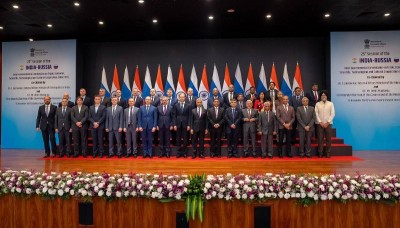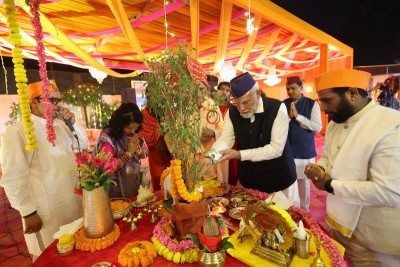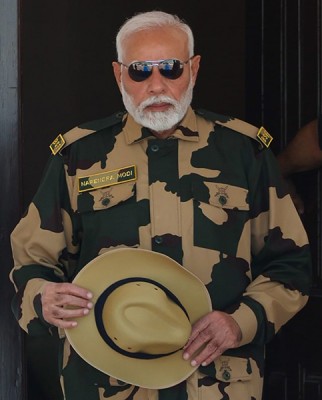
TTP: Enduring Shadows
Fourteen terrorists in the uniforms of the Constabulary stormed the mosque at the Airbase at 05:00 and dispersed into two groups, one of which went towards the administrative area, while the other headed for the technical section of the airbase. The Director-General (DG) Inter Services Public Relations (ISPR) Major General Asim Bajwa disclosed, "Terrorists busted the main gate with grenades and split into two groups. One group then targeted worshipers during morning prayers. The commandos and other security personnel surrounded the terrorists, contained them within 50 meters of the infiltration and killed 14 militants."
As they entered the Base, the militants killed three PAF technicians in the Guard Room, and then went on to kill 16 PAF soldiers who were praying at a mosque. Another seven PAF soldiers were killed in a barrack near the mosque. Army Captain Asfand Yar and two soldiers were killed in the counter-attack against the raiders. 10 soldiers were injured during exchange of fire with the terrorists, of whom two were officers. Some 15 persons were arrested during subsequent search operations.
DG Bajwa alleged, "The attackers came from Afghanistan and the whole foul play was planned in the neighbouring country. This attack was being executed through direct coordination from Afghanistan as well."
Meanwhile, TTP spokesperson Muhammad Khurasani claimed responsibility for the attack in an email sent to journalists.
The Badaber PAF base attack has several major precedents. Just a year earlier, on August 14, 2015, at least 12 terrorists wearing suicide vests and armed with RPGs and automatic weapons were killed, and 11 Security Force (SF) personnel were injured in an 11-hour gun battle near Khalid Aviation Airbase and Samungli Airbase in Quetta, The provincial capital of Balochistan. The TTP Ghalib Mehsud faction claimed responsibility for the attack on the Airbases in Quetta. Ghalib Mehsud is the leader of Fidayeen-e-Islam, TTP's suicide wing. TTP spokesperson Azam Tariq had announced that the attack was in retaliation for Operation Zarb-e-Azb in the North Waziristan Agency of Federally Administered Tribal Areas (FATA).
On September 6, 2014, terrorists planned to hijack Navy frigate PNS Zulfiqar at the West Wharf of the Karachi Dockyard. Naval Commandos of PNS Iqbal rushed to the scene and a gun battle ensued. One Naval officer was killed and seven were injured. Two attackers, including Owais Jakherani, a former Navy sailor, were killed, and four were captured alive.
August 16, 2012: Nine terrorists and two security personnel were killed when SFs foiled an attack on the Minhas PAF base at Kamra in the Attock District of Punjab. The Minhas Air Force base is believed to be one of the centres where Pakistan has stockpiled its nuclear arsenal. TTP 'spokesperson' Ehsanullah Ehsan claimed that four suicide bombers had carried out the attack to take revenge for the killings of the then TTP chief Baitullah Mehsud, and al Qaeda founder Osama bin Laden.
May 22, 2011: At least 10 SF personnel and five TTP militants were killed while nine SF personnel were injured in a TTP attack on the Pakistan Naval Station (PNS) Mehran within the Faisal Naval Airbase in Karachi. Two US made surveillance aircraft were damaged in the attack. Claiming responsibility for the attack, TTP spokesman Ehsanullah Ehsan declared, "We had already warned after Osama's martyrdom that we will carry out even bigger attacks".
October 10, 2009: Twelve Army personnel, including a Brigadier and a Lieutenant Colonel, were killed and five others were seriously injured when militants clad in Army uniforms attacked the General Headquarters (GHQ) of the Army in Rawalpindi. A splinter faction of the TTP claimed responsibility for the attack.
Despite the Government's claims of success of Operation Zarb-e-Azb in North Waziristan, the campaign is far from finished. Operation Zarb-e-Azb was launched on June 15, 2014, in the aftermath of the attack at the Jinnah International Airport, Karachi, on June 8-9, 2014. At least 33 persons, including all 10 attackers, were killed in the attack.
According to partial data (Data till September 20, 2015) compiled by the South Asia Terrorism Portal (SATP), Operation Zarb-e-Azb has, thus far, killed more than 2,130 'terrorists' and 226 soldiers (no independent verification of fatalities or identities of those killed is available, as media access to the areas of conflict is severely limited).
Significantly, on June 12, 2015, Major General Bajwa claimed that 347 officers and soldiers of the Pakistan Army had lost their lives, and 2,763 terrorists had been killed in the Operation. Up to 90 per cent of the North Waziristan was declared 'free from terrorists', while their central command and control apparatus, along with their communication systems, had been 'destroyed'. 9,000 intelligence operations had been conducted, as a result of which 218 wanted terrorists were killed, while thousands of extremists were taken for interrogation. 837 terrorist hideouts had been destroyed, while 253 tons of explosives were recovered during the ongoing operation. The Badaber base attack, however, demonstrates the audacity of the terrorist formations, despite numerous reverses.
Further, the National Action Plan (NAP) is making very slow progress. NAP was initiated on December 24, 2014, in the aftermath of the Peshawar Army Public School attack in which 148 persons, including 135 children, were killed. The '20-point Plan' on counter-terrorism was announced by Prime Minister Nawaz Sharif in a televised address to the nation in the night of December 24, 2014, and incorporated in the Constitution by the 21st Constitutional Amendment on January 7, 2015. A handout issued by the Federal Ministry of Interior on July 4, 2015, claimed that some 54,376 'combing operations' had been carried out under NAP, which came into effect on January 7, 2015, resulting in 60,420 arrests. 3,019 intelligence-based operations were also carried out, while 1,388 pieces of intelligence were shared. Some 97.9 million mobile SIM cards have been verified using bio-metric technology, while 5.1 million SIM cards have been blocked, under NAP.
Astonishingly, documents obtained by The News and reported on July 30, 2015, claimed that more than 20,000 terrorists had been killed by July 13, 2015, under NAP, an incredible number that does not reconcile with any estimates by official or non-Governmental monitoring agencies. Further, if such a large number has been killed, and terrorism still flourishes, what is the total strength of the terrorists in Pakistan? The documents also claimed that 3,148 terrorists had been apprehended across Pakistan while 1,799 persons had also been held under charges for 'hate speech'. 3,446 persons were identified as having links with banned outfits, and more than 100 madrassahs had been shut down, the documents claimed.
However, on September 10, 2015, Prime Minister Sharif lamented that provincial administrations were yet to implement a major portion of NAP to counter terrorism and extremism in the country. While some elements had been implemented, Sharif argued, it was necessary that each and every aspect of the anti-terrorism plan be implemented.
There is a visible element of deception here, as Pakistan projects its counter-terrorism 'successes' to secure as much as possible from the Coalition Support Fund (CSF) of United States in the name of Operations in its tribal areas. On September 13, 2015, Jonathan Carpenter, Special Representative of the US for Afghanistan and Pakistan, while appreciating Pakistan's war against terrorism, had thus observed that, as a result of Zarb-e-Azb, Waziristan and the Khyber Agency had become safer. Carpenter also confirmed that provision of CSF to Pakistan would continue for the current fiscal. Carpenter justified this decision on the basis of his talks with Prime Minister Sharif and the Government of Pakistan, who had assured him that an indiscriminate operation against all terrorist groups was under way.
The continued and free operation of a large number of 'friendly' terrorist formations in and from Pakistan - most prominently including the (Afghan) Taliban and a multiplicity of India-directed groups including the Lashkar-e-Taiba - gives the lie to Pakistan's claims of such an 'indiscriminate' operation. Indeed, it remains the case that anti-state formations such as TTP continue to flourish in Pakistan precisely because the state continues to provide spaces to a number of its own terrorist 'assets', as well as to the entire spectrum of Islamist extremist and sectarian political formations.
Pakistan continues on its trajectory to ruin, even as the 'international community', led by the US, continues to subsidize its many derelictions and to reward its enduring malfeasance. The terrorist attack at Badaber is just another reminder, the latest in an unending succession of disasters, that Pakistan's duplicity will eventually inflict a cost on the country itself, far beyond any calculus of gain its current masters may imagine.
Support Our Journalism
We cannot do without you.. your contribution supports unbiased journalism
IBNS is not driven by any ism- not wokeism, not racism, not skewed secularism, not hyper right-wing or left liberal ideals, nor by any hardline religious beliefs or hyper nationalism. We want to serve you good old objective news, as they are. We do not judge or preach. We let people decide for themselves. We only try to present factual and well-sourced news.







